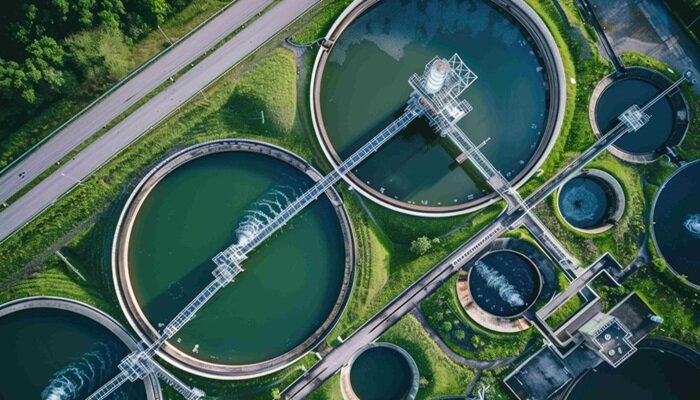Integrating H2S Removal in Wastewater Treatment Plant Designs
Managing hydrogen sulfide (H2S) in wastewater treatment plants is essential for safety, efficiency, and compliance. This gas, produced during the breakdown of organic matter, causes corrosion, foul odors, and health risks. Integrating H2S removal systems into plant designs is critical to prevent these issues and ensure long-term performance. Challenges Posed by H2S H2S forms in […] The post Integrating H2S Removal in Wastewater Treatment Plant Designs appeared first on World Construction Today.

Managing hydrogen sulfide (H2S) in wastewater treatment plants is essential for safety, efficiency, and compliance. This gas, produced during the breakdown of organic matter, causes corrosion, foul odors, and health risks. Integrating H2S removal systems into plant designs is critical to prevent these issues and ensure long-term performance.
Challenges Posed by H2S
H2S forms in low-oxygen environments like sewer lines and sludge digesters. Even at low levels, it’s toxic and corrosive, damaging plant infrastructure over time. It also produces strong odors, affecting nearby communities. For these reasons, effective H2S removal systems are a must in modern wastewater treatment plants. In addition, H2S can impact other gas streams, where its removal is equally important to ensure safe and efficient operations.
H2S is also a major component of sour gas, which poses similar challenges in natural gas processing, where H2S must be removed to ensure safety and operational efficiency.
Importance of Integrating H2S Removal in Plant Design
Hydrogen sulfide removal needs to be part of the plant’s design from the start to avoid costly repairs and safety hazards. Proper integration ensures smoother operations and regulatory compliance, preventing equipment damage and fines for emissions violations.
In wastewater treatment plants, addressing the challenges posed by H2S requires effective removal systems to maintain safe and efficient operations.
Types of H2S Removal Systems
Several systems are commonly used in wastewater treatment plants to remove or reduce H2S levels effectively. Each has its own advantages and applications, depending on factors such as the plant size, H2S concentration, and operational needs.
Granular Media Systems
Granular media systems utilize high-capacity media to capture and remove H2S from gas streams. These advanced H2S removal systems are designed for handling higher concentrations of H2S and can meet strict environmental regulations. Granular media systems offer reliable performance even in plants with fluctuating H2S levels, making them ideal for high-capacity removal needs.
They’re also easier to maintain, with simpler media replacement processes, which reduces downtime and operational complexity.
Iron Sponge Systems
Iron sponge systems work by passing H2S-laden gas through media coated with iron oxide, which reacts with the H2S to form solid sulfur compounds. Trusted providers like MV Technologies offer these systems, which are well-suited for plants dealing with low to moderate H2S levels and are known for their high performance and cost-effectiveness.
Iron sponge media needs to be replaced regularly once saturated, but the process is straightforward, making these systems a reliable option for many treatment facilities. This method is also effective for sulfur removal from gas streams, as well as for reducing volatile organic compounds (VOCs).

Activated Carbon Systems
Activated carbon systems are effective for removing H2S through adsorption. The gas is passed through a bed of activated carbon granules, which trap the H2S molecules on their surface. These systems are commonly used in smaller treatment plants or as a secondary method of H2S removal.
They’re particularly well-suited for moderate H2S concentrations. However, the carbon becomes saturated over time and needs to be replaced, which can drive up operational costs depending on the volume of H2S treated.
Chemical Scrubbers
Chemical scrubbers remove H2S by passing the gas through a liquid medium containing chemicals such as sodium hydroxide or chlorine. These systems are highly effective in removing large volumes of H2S, making them suitable for plants with high or fluctuating H2S concentrations.
While chemical scrubbers are efficient, they require continuous chemical replenishment and monitoring, which can increase operational costs over time.
Biological Scrubbers
Biological scrubbers rely on bacteria to metabolize and break down H2S into harmless byproducts such as sulfur and water. These systems are eco-friendly, as they use natural processes instead of chemicals.
Although biological scrubbers are typically low-maintenance once established, they’re sensitive to environmental factors such as temperature and pH levels. As such, they’re best suited for plants that maintain stable operational conditions and are looking for a sustainable, long-term solution.
Each H2S removal system offers unique benefits, making it essential to choose the right one based on the plant’s specific needs. With the appropriate system, wastewater treatment facilities can efficiently manage H2S levels while ensuring long-term operational success.
Designing for Long-Term H2S Control
Selecting the right H2S removal system depends on factors like plant size, operational needs, and H2S concentration. Integrating these systems from the outset helps prevent retrofitting costs and ensures safety for workers and nearby communities.
For smaller facilities, systems like activated carbon or granular media might be more cost-effective and easier to maintain. Larger plants dealing with higher H2S concentrations may benefit from chemical scrubbers or iron sponge systems that can handle larger volumes of gas.
Summing Up
Integrating the appropriate H2S removal system into a plant’s design is essential for managing H2S levels efficiently. This ensures smoother operations, extends the lifespan of equipment, and helps wastewater treatment facilities maintain safety and regulatory compliance over the long term.
The post Integrating H2S Removal in Wastewater Treatment Plant Designs appeared first on World Construction Today.

 machineryasia
machineryasia 




![[Job Story] Bobcat Fleet Constructing Italy’s Largest Agro-Photovoltaic Plants](https://www.heavyquipmag.com/wp-content/uploads/2025/12/bobcat-italy.jpg)



